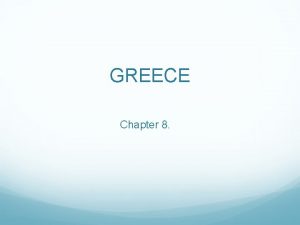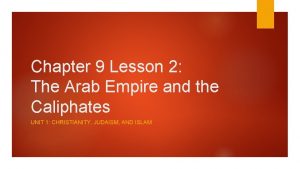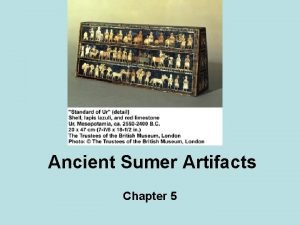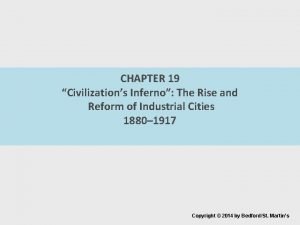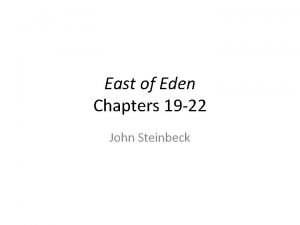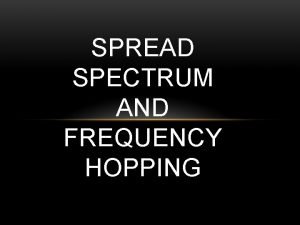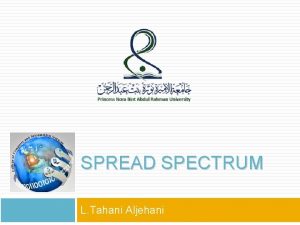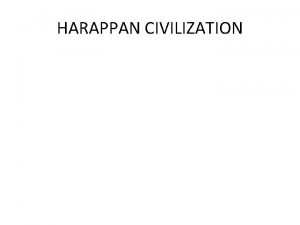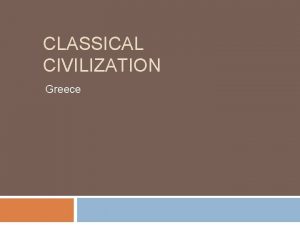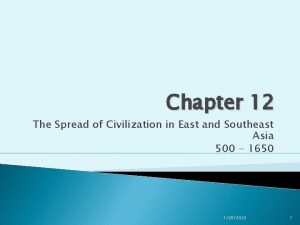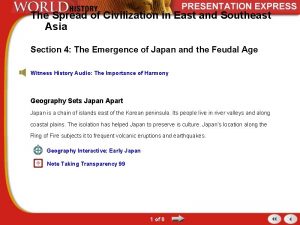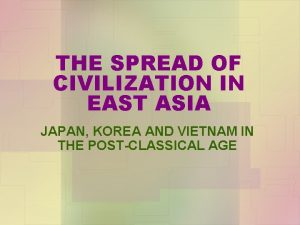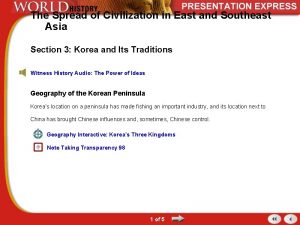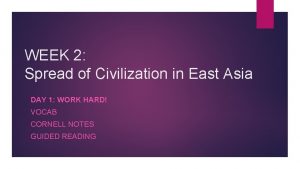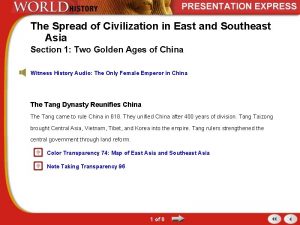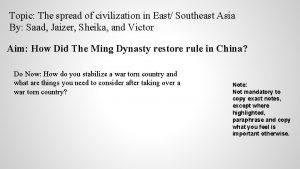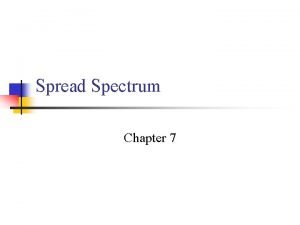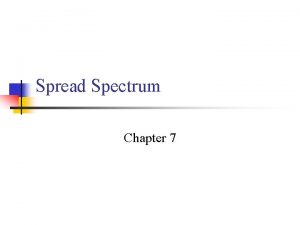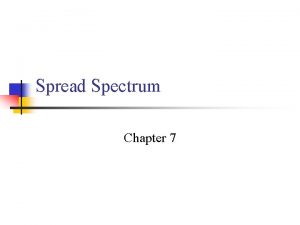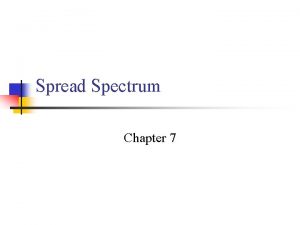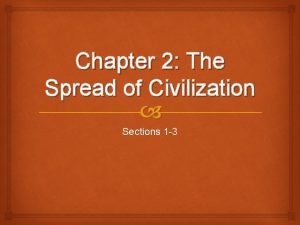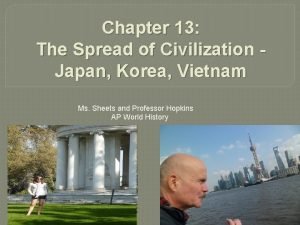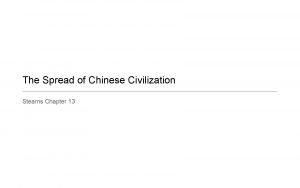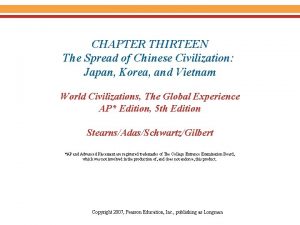Chapter 12 The Spread of Civilization in East


















































- Slides: 50

Chapter 12 The Spread of Civilization in East and Southeast Asia 500 -1650 Focus: How did China’s culture develop and influence it’s neighbors in East and Southeast Asia?

12. 1 – Two Golden Ages of China Focus: Describe the political, economic, and cultural achievements of the Tang and Song dynasties. § Tang Dynasty* (618) § Tang Taizong* § General, reformer, historian § Most admired Chinese emperor § Dynasty unifies China* § Extend control into Central Asia (conquer territory) § Tributary states – states that remain self-governing, but recognize Chinese supremacy and send regular tribute to the Tang emperor* § Vietnam, Tibet, Korea**


12. 1 – Two Golden Ages of China § Government & Economy § Rebuild bureaucracy § Enlarge civil service system* § Jobs based on skill not social class § Schools § Land reform – breaking up of large land holdings and redistributing land to peasants* § Strengthens central govn’t § Increases revenues - taxes § Weakens power of land owners

12. 1 – Two Golden Ages of China § Tang Dynasty Declines § Lost territories to Arabs § Corruption, high taxes, drought, famine, and rebellions § Tang emperor overthrown

12. 1 – Two Golden Ages of China § Song Dynasty (960) § Rule for 319 years § Constant threat of northern invaders § Forced south of the Huang River (1100 s) § Mongols overthrew Song (1200 s)*


12. 1 – Two Golden Ages of China § Song Prosperity* § Improved farming methods* § 2 crops a year instead of 1 § Creates surplus § Grand Canal used to ship food from South to North § Open border policy* § More people were able to pursue commerce, learning, and the arts

§ China’s Society § Gentry* § Wealthy landowners* § Govn’t service (bureaucracy) § Scholar-gentry – value learning § Peasantry* § Work the land* § Majority of population § Live in self-sufficient villages § Did not rely on govn’t § Move up in status 12. 1 – Two Golden Ages of China Emperor Gentry *main social class Peasantry *main social class Merchants § Merchants* § Lowest status* – riches come from the labor of others Slaves

12. 1 – Two Golden Ages of China § Women* § Home § Control family affairs – servants, finances § Boys valued more than girls § Young woman marries – joins husbands family § Dowry – payment woman brings to a marriage* § Never remarry

12. 1 – Two Golden Ages of China § Foot Binding* § Bound with long strips of cloth § Tiny lily shaped foot & stilted walk § Symbol of nobility & beauty* § Most need help to walk § Reinforced Confucian tradition that women should remain in the home*


12. 1 – Two Golden Ages of China § Culture § Pagoda* § Multistoried temple with eaves that curve up at the corners* § Porcelain* § “chinaware”

12. 2 – The Mongol and Ming Empires Focus: What were the effects of the Mongol invasion and the rise of the Ming dynasty on China? § Mongols § Nomads from Central Asia § Steppes – treeless grasslands* § Genghis Khan* – “Universal Ruler” § Mongol chieftain – unites warring tribes* § § Demands absolute loyalty Strict military discipline Fierce – massacre entire cities* Conquers lands from Eastern Europe to the Pacific Ocean


12. 2 – Mongol Armies Build An Empire § Rule of Conquered Lands § Not oppressive – toleration* – little change to lives of those conquered § Required to pay tribute* to Mongols § Trade* § Controlled Silk Road* § Cultural exchange flourished § Tolerated beliefs – Christians & Muslims § Send goods to Europe – gunpowder, porcelain, playing cards


12. 2 – China Under Mongol Rule § Kublai Khan* § Genghis Khan’s grandson § Conquered and ruled all of China, Korea, & Tibet – Yuan Dynasty § Government* § Only Mongols could serve in military* § Highest govn’t jobs – Mongols & non-Chinese § Chinese officials rule in provinces

12. 2 – China Under Mongol Rule § Marco Polo* § Merchant – Venice, Italy* § Served Kublai Khan for 17 years § The Travels of Marco Polo – sparks European interest in the riches of Asia*

12. 2 – Ming Restore Chinese Rule § Rebel army push Mongols out of China § Establish the Ming Dynasty *(1368) § § § Restore civil service system* Terrace farming* Repair canal system – trade easier – cities grow


12. 2 – Chinese Fleets Sail the Seas § Zheng He* § (1405 – 1433) Commanded seven expeditions* § Goal: promote trade & collect tribute from lesser powers – show power and strength of Chinese empire § 1435 – Zheng He dies § Emperor ends expeditions & bans building of seagoing ships* § Ends overseas exploration § Outside goods inferior**


12. 3 – Korea and Its Traditions Focus: How are Korea’s history and culture linked to those of China and Japan? § Geography* § Korea – peninsula south of Asian mainland* § Mtns. cover 70% § Live along western coastal plains – 5, 400 miles of coastline § Mtns. & Yalu River separate from China § Cultural & technological influence; political control § Pass traditions to Japan

12. 3 – Korea and Its Traditions § Silla Dynasty (668 -935) § Chinese missionaries spread Buddhism § Buddhist temples built

12. 3 – Korea and Its Traditions § Koryo Dynasty* (935 -1392) § Produce Buddhist texts using Chinese woodblock method § Invent movable metal type* § Improve Chinese porcelain § Celadon – porcelain with blue-green glaze*

12. 3 – Korea and Its Traditions § Choson Dynasty* § Last & longest of three dynasties § King Sejong – developed Korean writing system § Hangul – Korean phonetic alphabet; uses symbols to represent sounds of spoken Korean* § Easier to use than Chinese § **high literacy rate – percentage of people who can read or write*

12. 3 – Korea and Its Traditions § 1590 s § Japanese invade China by way of Korea – 6 years § Return to Japan – introduce Korean skills

12. 4 – The Emergence of Japan and the Feudal Age Focus: What internal and external factors shaped Japan’s civilization, and what characterized Japan’s feudal age? § Geography of Japan* § Archipelago – chain of islands* § 100 miles off Asian mainland § East of Korea § 4 main islands § Hokkaido, Honshu, Kyushu, Shikoku


12. 4 –Emergence of Japan and the Feudal Age § Geography § Seas – isolate and protect* § Accept or reject influences – preserve identity* § Thriving fishing industry § Trade routes § Ring of Fire – chain of volcanoes that encircle the Pacific Ocean § Tsunamis – underwater earthquake which creates deadly tidal waves*




12. 4 – The Emergence of Japan and the Feudal Age § Traditions § Yamato Clan (500) – first & only dynasty § Shinto – the worship of the forces of nature* § Honor kami – superior powers that are natural or divine § Language § Related to Korean § Kana – phonetic symbols representing syllables*

12. 4 – The Emergence of Japan and the Feudal Age § Japanese visit China § Nobles sent to study – introduce Chinese ideas to Japan § Centralized govn’t – bureaucracy § Chinese fashion, pottery, food, music, pagoda, Buddhism § Selective Borrowing – adopting some cultural traits while discarding others* § Example: reject Chinese civil service system – jobs based on status

12. 4 – The Emergence of Japan and the Feudal Age Warriors Establish Feudalism § Emperor § § top of feudal society powerless* - represents govn’t § Shogun* § Supreme military commander* § Holds real power* § Local warlords battle for control of countryside § Loyal to local lord – not central govn’t

12. 4 – The Emergence of Japan and the Feudal Age § Shogun § Gives land to warrior lords – daimyo* § Warrior lords § Give land to lesser warriors § samurai “those who serve”* § Follow bushido “way of the warrior” – code of values*

Feudal Society § Peasants – 75% of population § Crops § Foot soldiers § Merchants – lowest status


12. 4 – The Emergence of Japan and the Feudal Age Tokugawa Shogunate* (1600 – 1868) § Strengthened central govn’t – unified society – end to feudal warfare* § Control of Daimyo* § Required to live in Edo (capital) every other year* § Wife & children stay in Edo full time § Samurai § Military § Govn’t jobs § Peasants § Remain on land

12. 4 – The Emergence of Japan and the Feudal Age § Peace restored § Economy expands § Food surplus – population rise § Trade – new roads, cities grow

12. 4 – The Emergence of Japan and the Feudal Age Zen Buddhism § Zen – emphasized self-reliance, meditation, and devotion to duty*

12. 4 – The Emergence of Japan and the Feudal Age Artistic Traditions Change § Noh – plays performed on square wooden stage with no scenery § Kabuki – drama; historical events, moral conflicts, love relationships*

12. 5 – Diverse Cultures of Southeast Asia Focus: How was Southeast Asia affected by the cultures of both China and India? Southeast Asia – Geography* § Located between China & India* § influence § Mtns. Separate from mainland & divide river valleys § 2 regions: § Mainland: Myanmar, Thailand, Cambodia, Laos, Vietnam, part of Malaysia § Islands: 20, 000 including Indonesia, Singapore, Brunei, and the Philippines



Trade § Monsoons shape trade in southern seas § All sea trade b/w India & China had to pass through* § Between seasons – harbor boats in SE ports § Key product – spices* Traditions § § § Diverse, isolated villages Women – greater equality* Matrilineal descent was accepted custom

12. 5 – Diverse Cultures of Southeast Asia Culture § Indian beliefs – widespread acceptance § Hinduism, Buddhism, Islam* § Writing, mathematics, architecture, art

12. 5 – Diverse Cultures of Southeast Asia Vietnam* § China conquers north – Annam § Red River Delta § Rice paddies – fields* § Provide food for population § Adopt § § § Chinese civil service system Chinese language Chinese religion – Buddhism, Daoism § Vietnam Identity § 939 – Tang Dynasty collapsed § Break from China – remain tributary state
 Wind is horizontal movement of air
Wind is horizontal movement of air Laissez faire theory
Laissez faire theory East is east and west is west
East is east and west is west Protestant reformation ap world history
Protestant reformation ap world history Hình ảnh bộ gõ cơ thể búng tay
Hình ảnh bộ gõ cơ thể búng tay Slidetodoc
Slidetodoc Bổ thể
Bổ thể Tỉ lệ cơ thể trẻ em
Tỉ lệ cơ thể trẻ em Chó sói
Chó sói Tư thế worm breton là gì
Tư thế worm breton là gì Hát lên người ơi
Hát lên người ơi Kể tên các môn thể thao
Kể tên các môn thể thao Thế nào là hệ số cao nhất
Thế nào là hệ số cao nhất Các châu lục và đại dương trên thế giới
Các châu lục và đại dương trên thế giới Cong thức tính động năng
Cong thức tính động năng Trời xanh đây là của chúng ta thể thơ
Trời xanh đây là của chúng ta thể thơ Cách giải mật thư tọa độ
Cách giải mật thư tọa độ Làm thế nào để 102-1=99
Làm thế nào để 102-1=99 độ dài liên kết
độ dài liên kết Các châu lục và đại dương trên thế giới
Các châu lục và đại dương trên thế giới Thơ thất ngôn tứ tuyệt đường luật
Thơ thất ngôn tứ tuyệt đường luật Quá trình desamine hóa có thể tạo ra
Quá trình desamine hóa có thể tạo ra Một số thể thơ truyền thống
Một số thể thơ truyền thống Cái miệng bé xinh thế chỉ nói điều hay thôi
Cái miệng bé xinh thế chỉ nói điều hay thôi Vẽ hình chiếu vuông góc của vật thể sau
Vẽ hình chiếu vuông góc của vật thể sau Biện pháp chống mỏi cơ
Biện pháp chống mỏi cơ đặc điểm cơ thể của người tối cổ
đặc điểm cơ thể của người tối cổ V cc
V cc Vẽ hình chiếu đứng bằng cạnh của vật thể
Vẽ hình chiếu đứng bằng cạnh của vật thể Tia chieu sa te
Tia chieu sa te Thẻ vin
Thẻ vin đại từ thay thế
đại từ thay thế điện thế nghỉ
điện thế nghỉ Tư thế ngồi viết
Tư thế ngồi viết Diễn thế sinh thái là
Diễn thế sinh thái là Dạng đột biến một nhiễm là
Dạng đột biến một nhiễm là So nguyen to
So nguyen to Tư thế ngồi viết
Tư thế ngồi viết Lời thề hippocrates
Lời thề hippocrates Thiếu nhi thế giới liên hoan
Thiếu nhi thế giới liên hoan ưu thế lai là gì
ưu thế lai là gì Khi nào hổ mẹ dạy hổ con săn mồi
Khi nào hổ mẹ dạy hổ con săn mồi Sự nuôi và dạy con của hươu
Sự nuôi và dạy con của hươu Hệ hô hấp
Hệ hô hấp Từ ngữ thể hiện lòng nhân hậu
Từ ngữ thể hiện lòng nhân hậu Thế nào là mạng điện lắp đặt kiểu nổi
Thế nào là mạng điện lắp đặt kiểu nổi Chapter 8 lesson 1 greek culture
Chapter 8 lesson 1 greek culture Lesson 2 the arab empire and the caliphates
Lesson 2 the arab empire and the caliphates Sumer
Sumer Chapter 19 civilization's inferno
Chapter 19 civilization's inferno East of eden chapter 25
East of eden chapter 25














































